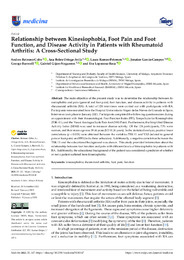Please use this identifier to cite or link to this item:
https://hdl.handle.net/11000/31081Full metadata record
| DC Field | Value | Language |
|---|---|---|
| dc.contributor.author | Reinoso Cobo, Andrés | - |
| dc.contributor.author | Ortega-Avila, Ana Belen | - |
| dc.contributor.author | Ramos-Petersen, Laura | - |
| dc.contributor.author | Garcia-Campos, Jonatan | - |
| dc.contributor.author | Banwell, George | - |
| dc.contributor.author | Gijon-Nogueron, Gabriel | - |
| dc.contributor.author | Lopezosa-Reca, Eva | - |
| dc.contributor.other | Departamentos de la UMH::Ciencias del Comportamiento y salud | es_ES |
| dc.date.accessioned | 2024-02-05T17:33:39Z | - |
| dc.date.available | 2024-02-05T17:33:39Z | - |
| dc.date.created | 2023-01-11 | - |
| dc.identifier.citation | Medicina (Kaunas). 2023 Jan 11;59(1):147 | es_ES |
| dc.identifier.issn | 1648-9144 | - |
| dc.identifier.issn | 1010-660X | - |
| dc.identifier.uri | https://hdl.handle.net/11000/31081 | - |
| dc.description.abstract | The main objective of the present study was to determine the relationship between kinesiophobia and pain (general and foot pain), foot function, and disease activity in patients with rheumatoid arthritis (RA). A total of 124 interviews were carried out with participants with RA. Participants were recruited from the Hospital Universitario Virgen de las Nieves de Granada in Spain. Interviews took place in January 2021. Participants completed the following questionnaires during an appointment with their rheumatologist: Foot Function Index (FFI), Tampa Scale for Kinesiophobia (TSK-11), and the Visual Analogue Scale Pain foot (VAS Pain). Furthermore, the Simplified Disease Activity Index (SDAI) was used to measure disease activity. Of the 124 participants, 73% were women, and their mean age was 59.44 years (SD 11.26 years). In the statistical analysis, positive linear correlations (p < 0.001) were obtained between the variables TSK-11 and VAS (related to general pain or foot pain) and FFI (in its three subscales). Additionally, a negative correlation between the TSK-11 and the educational background was shown. This study provided information about the relationship between foot function and pain with different levels of kinesiophobia in patients with RA. Additionally, the educational background of the patient was considered a predictor of whether or not a patient suffered from kinesiophobia. | es_ES |
| dc.format | application/pdf | es_ES |
| dc.format.extent | 9 | es_ES |
| dc.language.iso | eng | es_ES |
| dc.publisher | MDPI | es_ES |
| dc.rights | info:eu-repo/semantics/openAccess | es_ES |
| dc.rights | Attribution-NonCommercial-NoDerivatives 4.0 Internacional | * |
| dc.rights.uri | http://creativecommons.org/licenses/by-nc-nd/4.0/ | * |
| dc.subject | Kinesiophobia | es_ES |
| dc.subject | Rheumatoid arthritis | es_ES |
| dc.subject | Foot | es_ES |
| dc.subject | Pain | es_ES |
| dc.subject | Function | es_ES |
| dc.title | Relationship between Kinesiophobia, Foot Pain and Foot Function, and Disease Activity in Patients with Rheumatoid Arthritis A Cross-Sectional Study | es_ES |
| dc.type | info:eu-repo/semantics/article | es_ES |
| dc.relation.publisherversion | https://doi.org/10.3390/medicina59010147 | es_ES |

View/Open:
Relationship between Kinesiophobia, Foot Pain and Foot.pdf
338,71 kB
Adobe PDF
Share:
.png)
